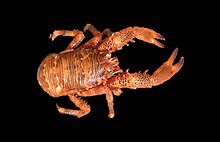
Homarus gammarus, known as the European lobster or common lobster, is a species of clawed lobster from the eastern Atlantic Ocean, Mediterranean Sea and parts of the Black Sea. It is closely related to the American lobster, H. americanus. It may grow to a length of 60 cm (24 in) and a mass of 6 kilograms (13 lb), and bears a conspicuous pair of claws. In life, the lobsters are blue, only becoming "lobster red" on cooking. Mating occurs in the summer, producing eggs which are carried by the females for up to a year before hatching into planktonic larvae. Homarus gammarus is a highly esteemed food, and is widely caught using lobster pots, mostly around the British Isles.

Squat lobsters are dorsoventrally flattened crustaceans with long tails held curled beneath the cephalothorax. They are found in the two superfamilies Galatheoidea and Chirostyloidea, which form part of the decapod infraorder Anomura, alongside groups including the hermit crabs and mole crabs. They are distributed worldwide in the oceans, and occur from near the surface to deep sea hydrothermal vents, with one species occupying caves above sea level. More than 900 species have been described, in around 60 genera. Some species form dense aggregations, either on the sea floor or in the water column, and a small number are commercially fished.
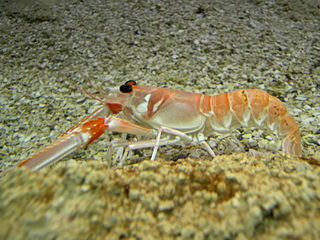
Nephrops norvegicus, known variously as the Norway lobster, Dublin Bay prawn, langoustine or shrimp, is a slim, coral colored lobster that grows up to 25 cm (10 in) long, and is "the most important commercial crustacean in Europe". It is now the only extant species in the genus Nephrops, after several other species were moved to the closely related genus Metanephrops. It lives in the north-eastern Atlantic Ocean, and parts of the Mediterranean Sea, but is absent from the Baltic Sea and Black Sea. Adults emerge from their burrows at night to feed on worms and fish.

Cancer pagurus, commonly known as the edible crab or brown crab, is a species of crab found in the North Sea, North Atlantic Ocean, and perhaps the Mediterranean Sea. It is a robust crab of a reddish-brown colour, having an oval carapace with a characteristic "pie crust" edge and black tips to the claws. A mature adult may have a carapace width up to 25 centimetres and weigh up to 3 kilograms. C. pagurus is a nocturnal predator, targeting a range of molluscs and crustaceans. It is the subject of the largest crab fishery in Western Europe, centred on the coasts of the Ireland and Britain, with more than 60,000 tonnes caught annually.

Metanephrops challengeri is a species of slim, pink lobster that lives around the coast of New Zealand. It is typically 13–18 cm (5–7 in) long and weighs around 100 g (3.5 oz). The carapace and abdomen are smooth, and adults are white with pink and brown markings and a conspicuous pair of long, slim claws. M. challengeri lives in burrows at depths of 140–640 m (460–2,100 ft) in a variety of sediments. Although individuals can live for up to 15 years, the species shows low fecundity, where small numbers of larvae hatch at an advanced stage.

Palinurus elephas is a commonly caught species of spiny lobster from the East Atlantic Ocean and the Mediterranean Sea. Its common names include European spiny lobster, crayfish or cray, crawfish, common spiny lobster, Mediterranean lobster and red lobster.

Porcellana platycheles, the broad-clawed porcelain crab, is a species of porcelain crab from the family Porcellanidae. It is found on the coasts of the eastern Atlantic Ocean and in the Mediterranean Sea
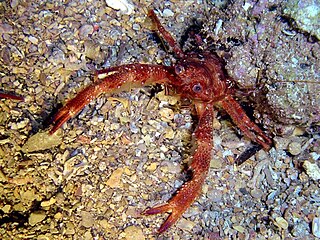
Galathea intermedia is a species of squat lobster in the family Galatheidae. It is found in the north-eastern Atlantic Ocean, as far north as Troms, Norway, south to Dakar and the Mediterranean Sea.

Galathea strigosa is a species of squat lobster in the family Galatheidae. It is found in the northeast Atlantic Ocean, from the North Cape to the Canary Islands, and in the Mediterranean Sea and Red Sea. It is edible, but not fished commercially. It is the largest squat lobster in the northeast Atlantic, reaching a length of 90 millimetres (3.5 in), or a carapace length of 53 mm (2.1 in), and is easily identified by the transverse blue stripes across the body.

Pilumnus hirtellus, the bristly crab or hairy crab, is a species of European crab. It is less than 1 inch (25 mm) long and covered in hair. It lives in shallow water and feeds on carrion.

Polycheles typhlops is a species of blind, deep water decapod crustacean with a cosmopolitan distribution. It is "one of the dominant and most characteristic crustaceans in deep-sea communities of the Mediterranean Sea".

Scyllarides latus, the Mediterranean slipper lobster, is a species of slipper lobster found in the Mediterranean Sea and in the eastern Atlantic Ocean. It is edible and highly regarded as food, but is now rare over much of its range due to overfishing. Adults may grow to 1 foot (30 cm) long, are camouflaged, and have no claws. They are nocturnal, emerging from caves and other shelters during the night to feed on molluscs. As well as being eaten by humans, S. latus is also preyed upon by a variety of bony fish. Its closest relative is S. herklotsii, which occurs off the Atlantic coast of West Africa; other species of Scyllarides occur in the western Atlantic Ocean and the Indo-Pacific. The larvae and young animals are largely unknown.

Eumunida picta is a species of squat lobster found in the deep sea. The species is strongly associated with reefs of Lophelia pertusa, a deep-water coral, and with methane seeps. It is abundant in the western Atlantic Ocean, where it is found from Massachusetts to Colombia.

Crustaceans may pass through a number of larval and immature stages between hatching from their eggs and reaching their adult form. Each of the stages is separated by a moult, in which the hard exoskeleton is shed to allow the animal to grow. The larvae of crustaceans often bear little resemblance to the adult, and there are still cases where it is not known what larvae will grow into what adults. This is especially true of crustaceans which live as benthic adults, more-so than where the larvae are planktonic, and thereby easily caught.
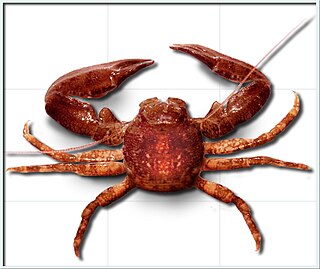
Pisidia longicornis, the long-clawed porcelain crab, is a species of porcelain crab that lives in the north-eastern Atlantic Ocean. It varies from reddish to white, and grows to a carapace width of 1 cm (0.4 in). It was first named by Carl Linnaeus in 1767, although the etymology remains unclear.

Munida rugosa, commonly known as the rugose squat lobster or plated lobster, is a species of decapod crustacean found in the north east Atlantic Ocean and the Mediterranean Sea.
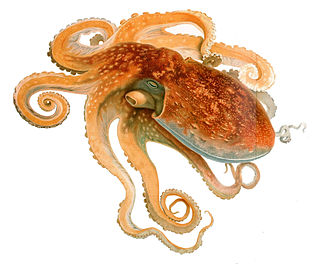
The curled octopus, also known as the horned octopus, lesser octopus or northern octopus, is a species of cephalopod found in the northeast Atlantic, ranging from Norway to the Mediterranean, including the British Isles. The total length of an adult is around 50 cm, but their arms are often tightly curled. It immobilises and eats large crustaceans by drilling a hole through their shell. It is mainly by-catch in commercial fisheries of the north eastern Atlantic and Mediterranean, where the common octopus is the preferred species.

Geryon trispinosus is a species of crab that lives in deep water in the north-eastern Atlantic Ocean.
Brachynotus sexdentatus is a species of crab in the family Varunidae. It is native to the Mediterranean Sea and Black Sea, and became established for a time in Swansea Docks. It grows to a maximum carapace width of 18 mm (0.71 in), and lives in shallow water on muddy bottoms.
